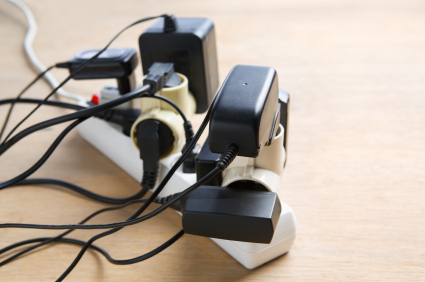Send your question to Umbra!
Q. Dear Umbra,
I know it’s supposed to be bad to leave your cell phone charger plugged in when it’s not charging, but here’s something I find myself wondering often: Is it as bad to leave it plugged in with your phone attached after it’s been charged? And what about my laptop charger? Does that leak energy? Can’t remember if you’ve covered this before.
T.G.
Oakland, Calif.
 A. Dearest T.G.,
A. Dearest T.G.,
I have indeed covered some of this before, once or twice, but your question is timely: Just last month, your fine state adopted new energy-efficiency rules for chargers, citing potential residential and commercial savings of $306 million a year. Also, I am all zinged up by your question about leaving chargers attached to gadgets when their job is done — an important, but often overlooked, variable in this multi-pronged energy equation.
First, a refresher on things that plug in, which allows us to bandy about two fun terms. “Vampires” are appliances that suck energy even when you think they’re shut off, like microwaves, DVRs, TVs, and game systems. Anything with a cute little light or digital clock on it is drawing power, usually unnecessarily, and costing you money — one estimate from Cornell University suggests these vampires cost an average household $200 per year. Unplug these items when you’re finished with them, or better yet, use a power strip.
Our other offenders are “wall warts” — a nose-wrinkling term for those chargers with oversized, boxy plugs — and other AC adapters. In a national display of incomprehensible laziness, these power supplies are often left plugged in when disconnected from the gadget in question. It’s as if you decided to pour yourself some orange juice, filled up the glass, and then just left the jug lying on its side, the top off, contents spilling everywhere. Why, people, why?
My tidiness issues aside, it turns out there’s only one thing worse than leaving a charger plugged in with no device attached: leaving it plugged in and charging for too long. Now, T.G., we get to the heart of your question, but we must travel along slightly divergent arteries to discuss your phone and computer.
According to our very thorough, very reliable friends at the Lawrence Berkeley National Laboratory, who measured several devices in each category, a cell-phone charger draws an average of 3.68 watts when the phone is on and charging; 2.24 watts when it is on and charged; and 0.26 watts when it is just hanging out in the socket. So put very simply, leaving your charged phone attached to the charger uses 10 times the energy that leaving the charger dangling would. None of this amounts to much on its own; the Berkeley Lab people estimate that each watt they measured translates into roughly $1 per year of energy expenses, so we’re talking about $3-$4 per charger, per year. But when you consider all the chargers in your house, then multiply it by the 115 million or so households in the U.S., it adds up.
Your laptop follows a similar-but-higher-stakes pattern, drawing an average of 44.28 watts when it is charging; 29.48 watts when it is charged; and 4.42 watts when we let the charger dangle. Laptops get a bit more complicated, because keeping them plugged in can actually be a good thing — it’s more efficient to use that power to run the machine than to use it to charge a battery which then runs the machine. So if you’re going to be stationary for any length of time, consider keeping the machine plugged in (be sure to check your manufacturer’s recommendations, as they do vary). Also, ignore people who try to scare you about having to charge, discharge, and recharge your battery; today’s lithium-ion models do not need such handholding (here are a few tips for making your Li-ion battery last).
T.G., if you’re feeling forgetful when it comes to your chargers, I have a few ideas:
- Create a central charging area for all the devices in your house, using a power strip (with a timer, even) to ensure that nothing is left on longer than needed.
- Check out alternative chargers like wind-up or solar devices.
- Buy a watt meter, which can be had for $20-$40, to see how much energy you’re using around the house, and how much it costs. (To give you a sense of scale, many users report that dangling chargers use so little energy as to not register on these meters.)
- When the time comes to buy new electronics, look for the Energy Star label.
Frankly, I’m of two minds about whether we should all freak out about chargers. Standby power use is responsible for an estimated 1 percent of global CO2 emissions, and every little bit certainly counts. But if you haven’t taken bigger steps like insulating your house or embracing public transportation, fretting over wall warts might not be the best use of your energy.
Juicily,
Umbra



